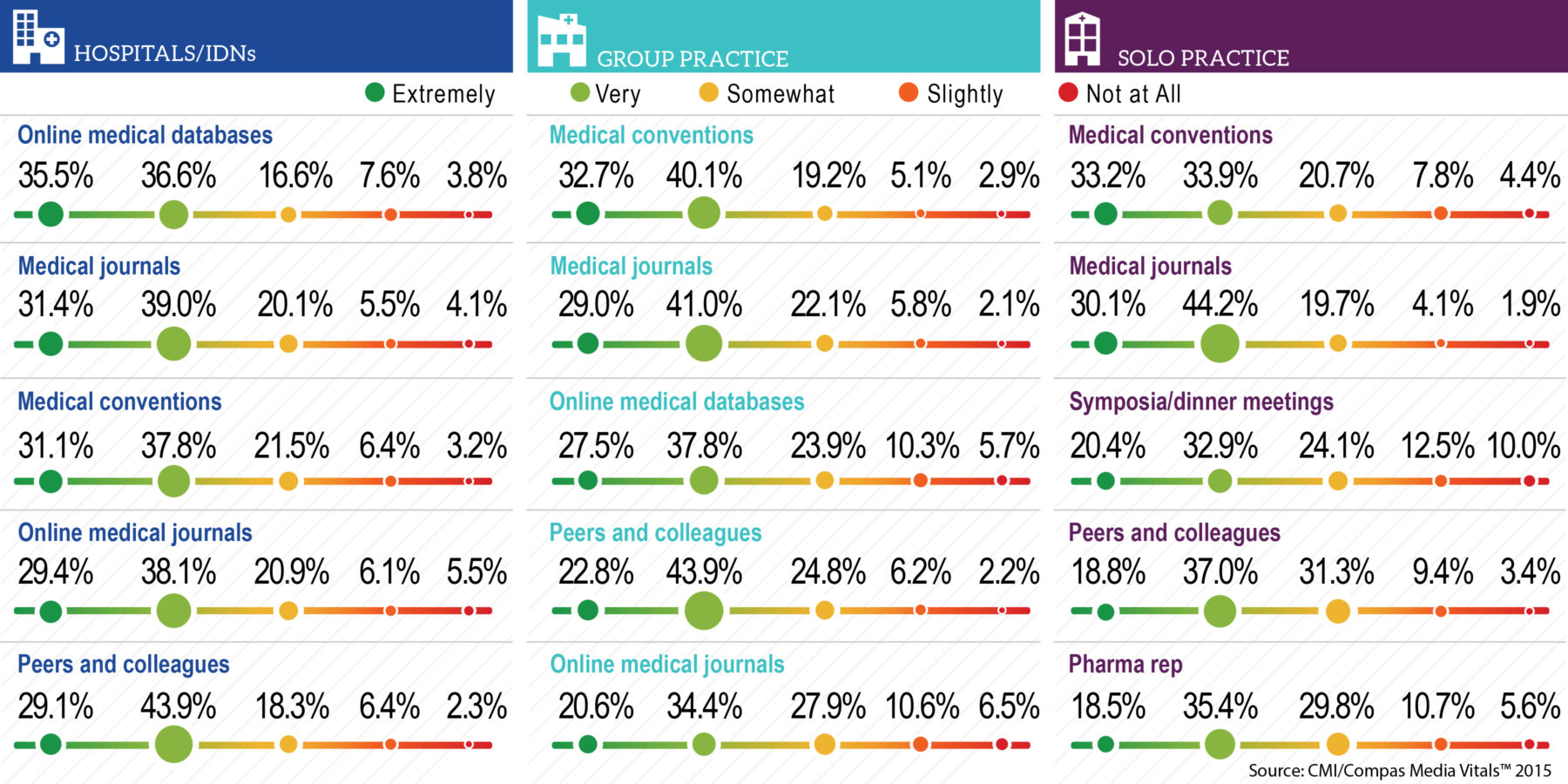CMI/Compas’ annual Media Vitals report examines what physicians want from pharma, including a closer look at prescriber promotional preferences. For example, the chart below shows a breakdown of the channels physicians use to get medical information based on their practice type: Solo, group or hospital practices.
“What we found is that regardless of practice type, prescribers are information seekers, and in order to best serve their patients, they use various methods to obtain this information,” explains Wayne Obetz, VP, Investment Analytics & Decision Sciences at CMI/Compas. “Physicians value any channel that can get them information and tend to use multiple channels. Where differences were observed, hospital-based doctors appear to be more tech-savvy and slightly younger than the doctors in solo practice. In addition, solo practice physicians seem to put more credence in what they’re hearing from pharma, while those based in hospitals tend to want to do more third-party investigations, and may not be as receptive to messages delivered directly from pharma companies.”
So how can pharma marketers use this information to their advantage to better engage with physicians? Various experts from within CMI/Compas offer actionable insights to marketers based on the information gleaned in Media Vitals 2015.
How Should You Plan to Engage Each Type of Prescriber?
Word of Mouth: “It’s important to consider the impact of the promotional dollar by supporting word of mouth marketing,” explains Melissa Wackes, Associate Director, Media. “Practice type may lead to changes in ability to adopt certain therapies because of group or hospital mandates to follow guidelines. Because of this, physicians may seek third-party sources to lend credibility to changes in group practice guidelines or hospital practices. Or, for example in group practices, perhaps only one physician is receiving information from reps or through a specific non-personal promotion (NPP) channel, but they share it with their peers. So pharma marketers may only reach one physician but their decisions may influence others.”
Channel agnostic plans: Karysse Robinson, Supervisor, Media, says that based on the data displayed above, a marketer’s overall philosophy should point to channel agnostic plans as no channels over-index more than others between the groups. And that includes print. “Each year we hear worries that it’s a dying medium, but it’s thriving,” she adds. “It’s a preferred resource for a lot of HCPs.”
Multichannel Plans Emphasizing Third Parties: “Since hospital-based doctors tend to be motivated more by third-party information, we would suggest a multichannel plan that emphasizes programs with third parties,” offers Karima Sharif, VP, Media and Advanced Audience Engagements. “The multichannel perspective allows marketers to partner with publishers and third-party content providers to create NPP programs that motivate physicians because they are created based on preferences.”
What Can Marketers Do to Take Advantage of the Differences Between Prescriber Types?
Consider the Logistics: “A physician in a solo practice has a mailing address and is probably getting an influx of communication through the mail, while a hospital-based physician is on the move and may not have a real office within the hospital,” explains Kate Zwizanski, VP Media. “Because of that nomadic nature of their practice, they need to be able to get their information quickly, so they have an even higher propensity toward using search engines than their office-based peers.”
According to Wackes, this means these physicians probably have different messaging needs. “Hospital target physicians probably need different information to make that prescribing decision, versus the practice-based who may manage a different patient mix, perhaps with more chronic disease treatment,” she explains. “Marketers need to deliver the messages physicians need, targeting different messages by channel, based on which the physician will likely use and for what purposes.
Tailor Your Messaging: Andrew Driver, Supervisor, Insights & Analytics, believes marketers need to start having a deeper conversation with creative agencies about messaging and concepts. “Hospitalists might be more interested around information regarding guidelines while private practice docs could find more interest with formulary information,” he explains. “There are many things that need to be considered such as looking at developing different concepts for each audience, specific and relevant landing pages, co-pay/dosing pages or formulary maps, to create different conversions. Don’t approach this as a ‘one-size fits all’ mindset.”
Ask Why: “Coming from the market research side, we suggest asking more probing questions to determine what’s actionable,” adds Kaitlin Lucas, Marketing Research Coordinator. “For instance: What can you do to guide them to different channels? What is the way to be more impactful in the channels they prefer? In the research we see that solo prescribers prefer less digital channels. Ask why. I would want to know the reasons behind their preferences.”
What Best Practices Can Marketers Take Away From This Data?
Know Your Customer List: “There’s no one plan that works for everyone, you can’t do the same thing for two different campaigns and expect the same result,” explains Zwizanski. “This goes back to knowing your customer list and its makeup. Depending on your category that can really vary.”
According to Sharif, marketers need to figure out the wants and needs of the physicians on their customer list. “Different specialties work with pharma in different ways,” she offers. “For example, oncologists have distinct access points and messaging needs than primary care physicians or even rheumatologists do, so understanding those up-front is necessary.”
Personalized Marketing: “Media can be targeted in very specific and strategic ways,” offers Obetz. “Brands do not need to be content with a broad brush, reaching physicians only by specialty—it is now possible to incorporate other details about the physicians and their practices, which influence their information seeking behaviors. Brands can begin to personalize the information they send, confident that they are providing value to physicians based on what we know about what information a physician needs and can act on, and how they are likely to access it.”







